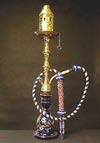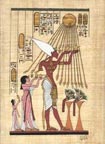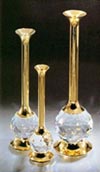|
KHAN EL KHALILI BAZAAR
 Khan el-Khalili, once known as the Turkish bazaar during the
Ottoman period, is now usually just called the 'Khan'. The
market was built in 1382 by the Emir Djaharks el-Khalili in the
heart of the Fatimid City. Together with the al-Muski market to
the west, they comprise one of Cairo's most important shopping
areas. But more than that, they represent the market tradition
which established Cairo as a major center of trade, and at the
Khan, one will still find foreign merchants. Perhaps, this vary
market was involved in the spice monopoly controlled by the
Mamluks, which encouraged the Europeans to search for new routes
to the East and led Columbus, indirectly, to discover the
Americas. Khan el-Khalili, once known as the Turkish bazaar during the
Ottoman period, is now usually just called the 'Khan'. The
market was built in 1382 by the Emir Djaharks el-Khalili in the
heart of the Fatimid City. Together with the al-Muski market to
the west, they comprise one of Cairo's most important shopping
areas. But more than that, they represent the market tradition
which established Cairo as a major center of trade, and at the
Khan, one will still find foreign merchants. Perhaps, this vary
market was involved in the spice monopoly controlled by the
Mamluks, which encouraged the Europeans to search for new routes
to the East and led Columbus, indirectly, to discover the
Americas.
 During its early period, the market was also a center
for subversive groups, often subject to raids before the Sultan Ghawri rebuilt much of the area in the early 16th century.
Regardless, it was trade which caused Cairo's early wealth, even
from the time of the Babylon fort which was often a settlement
of traders. During its early period, the market was also a center
for subversive groups, often subject to raids before the Sultan Ghawri rebuilt much of the area in the early 16th century.
Regardless, it was trade which caused Cairo's early wealth, even
from the time of the Babylon fort which was often a settlement
of traders.
 This market is situated at one corner of a triangle of markets
that go south to Bab Zuwayla and west to Azbakiyyah. The Khan is
bordered on the south by al-Azhar Street and on the west by the
Muski Market. One of the old original gates guards the entrance
to the original courtyard which lies midway down Sikkit al-Badistan
(street). On a narrow street leading off al-Badistand, one will
find the El-Fishawi Cafe, or Cafe of Mirrors, which was once a
meeting place for local artists, and is still frequented by the
Nobel Award winning Naguib Mahfouz, one of Egypt's most well
known authors. There are any number of canvas covered streets
such as the one pictured to the right. This market is situated at one corner of a triangle of markets
that go south to Bab Zuwayla and west to Azbakiyyah. The Khan is
bordered on the south by al-Azhar Street and on the west by the
Muski Market. One of the old original gates guards the entrance
to the original courtyard which lies midway down Sikkit al-Badistan
(street). On a narrow street leading off al-Badistand, one will
find the El-Fishawi Cafe, or Cafe of Mirrors, which was once a
meeting place for local artists, and is still frequented by the
Nobel Award winning Naguib Mahfouz, one of Egypt's most well
known authors. There are any number of canvas covered streets
such as the one pictured to the right.
Popular Islamic Places: |